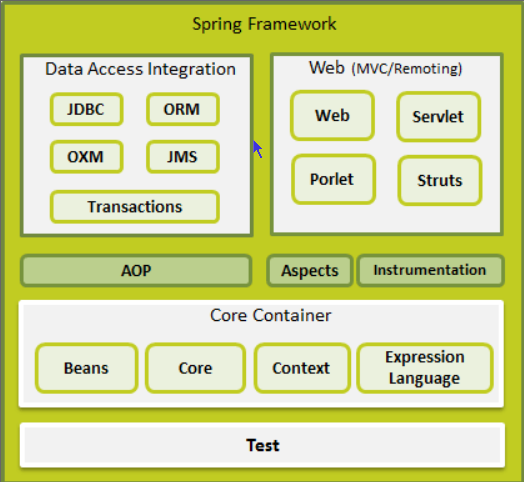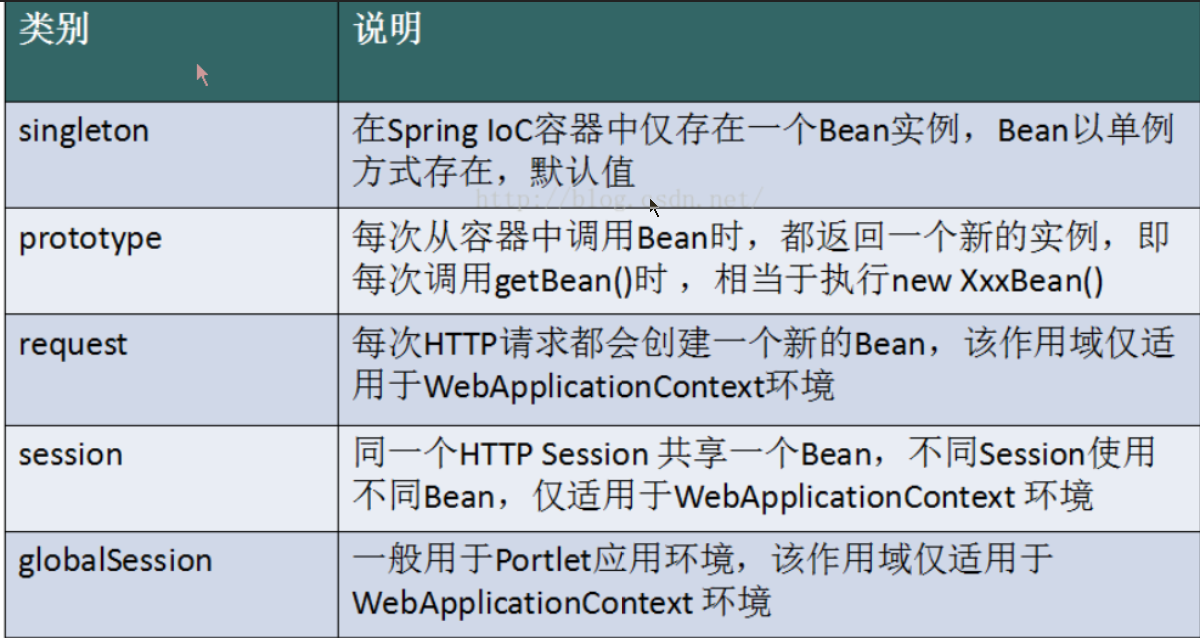介绍
什么是spring-framework
Spring是分层的JavaSE/EE应用一站式的轻量级开源框架。以ioc(Inverse of control)控制反转和Aop(Aspect Oriented Programming)面向切面编程为核心 ,
Spring是一个开源应用框架,旨在降低应用程序开发的复杂度。- 它是轻量级、松散耦合的。
- 它具有分层体系结构,允许用户选择组件,同时还为
J2EE应用程序开发提供了一个有凝聚力的框架。 - 它可以集成其他框架,如
Structs、Hibernate、EJB等,所以又称为框架的框架。
相关jar包
spring-core是Spring的核心工具包spring-cji是核心包所需的依赖包,spring-aop:Spring的面向切面编程,提供AOP(面向切面编程)的实现spring-beans:Spring IOC的基础实现,包含访问配置文件、创建和管理bean等spring-context:在基础IOC功能上提供扩展服务,此外还提供许多企业级服务的支持,有邮件服务、任务调度、JNDI定位,EJB集成、远程访问、缓存以及多种视图层框架的支持spring-expression:spring表达式语言,就像EL表达式一样的东西commons-logging:这个是只是一个日志包
看下面官网给的一张spring框架的结构图:

Spring核心容器– 该层基本上是
Spring Framework的核心。它包含以下模块:Spring CoreSpring BeanSpEL (Spring Expression Language)Spring Context
数据访问/集成
– 该层提供与数据库交互的支持。它包含以下模块:
DBC (Java DataBase Connectivity)ORM (Object Relational Mapping)OXM (Object XML Mappers)JMS (Java Messaging Service)Transaction
Web– 该层提供了创建
Web应用程序的支持。它包含以下模块:WebWeb – ServletWeb – SocketWeb – Portlet
AOP– 该层支持面向切面编程Instrumentation– 该层为类检测和类加载器实现提供支持。Test– 该层为使用JUnit和TestNG进行测试提供支持。几个杂项模块:
Messaging– 该模块为STOMP提供支持。它还支持注解编程模型,该模型用于从WebSocket客户端路由和处理STOMP消息。Aspects– 该模块为与AspectJ的集成提供支持。
优点
方便解耦,简化开发:
Spring就是一个大工厂,可以将所有对象创建和依赖关系维护,交给Spring管理AOP编程的支持:Spring提供面向切面编程,可以方便的实现对程序进行权限拦截、运行监控等功能声明式事务的支持:
只需要通过配置就可以完成对事务的管理,而无需手动编程方便程序的测试:
Spring对Junit4支持,可以通过注解方便的测试Spring程序方便集成各种优秀框架:
Spring不排斥各种优秀的开源框架,其内部提供了对各种优秀框架(如:Struts、Hibernate、MyBatis、Quartz等)的直接支持
6.降低JavaEE API的使用难度:Spring对JavaEE开发中非常难用的一些API(JDBC、JavaMail、远程调用等),都提供了封装,使这些API应用难度大大降低
配置
xml配置<?xml version="1.0" encoding="UTF-8"?> <beans xmlns="http://www.springframework.org/schema/beans" xmlns:xsi="http://www.w3.org/2001/XMLSchema-instance" xsi:schemaLocation="http://www.springframework.org/schema/beans http://www.springframework.org/schema/beans/spring-beans.xsd"> <bean id="hello" class="com.cherry.Students"> <property name="name" value="spring"/> </bean> </beans>//三种方式(第一种常用) //第一种立即创建对象,适合单例对象,从项目配置文件加载 ApplicationContext contexta = new ClassPathXmlApplicationContext("spring-config.xml"); //第二种从磁盘任意位置加载 ApplicationContext contextb = new FileSystemXmlApplicationContext("C:\\Users\\17598\\Desktop\\spring-config.xml"); //第三种半配置问价半注解的方式 ApplicationContext contextc = new AnnotationConfigApplicationContext("spring-config.xml");
注入
构造器注入
spring的IOC容器默认通过无参构造器去new对象当参数为非字符串类型时,在配置文件中需要制定类型,如果不指定类型一律按照字符串类型赋值。
当参数类型不一致时,框架是按照字符串的类型进行查找的,因此需要在配置文件中制定是参数的位置。
<!-- 通过构造器参数索引方式依赖注入 --> <bean id="helloBeanByIndex" class="com.lyc.cn.day04.HelloImpl"> <constructor-arg index="0" value="小张"/> <constructor-arg index="1" value="3"/> </bean> <!-- 通过构造器参数类型方式依赖注入 --> <bean id="helloBeanByType" class="com.lyc.cn.day04.HelloImpl"> <constructor-arg type="java.lang.String" value="小李"/> <constructor-arg type="int" value="4"/> </bean> <!-- 通过构造器参数名称方式依赖注入 --> <bean id="helloBeanByName" class="com.lyc.cn.day04.HelloImpl"> <constructor-arg name="name" value="小王"/> <constructor-arg name="age" value="5"/> </bean>
setter注入student类public class Student { private String name; private Address address; private String[] books; private List<String> hobbies; private Map<String,String> card; private Set<String> games; private String wife; private Properties info; }xml配置<?xml version="1.0" encoding="UTF-8"?> <beans xmlns="http://www.springframework.org/schema/beans" xmlns:xsi="http://www.w3.org/2001/XMLSchema-instance" xsi:schemaLocation="http://www.springframework.org/schema/beans http://www.springframework.org/schema/beans/spring-beans.xsd"> <bean id="address" class="com.cherry.Address"> <property name="address" value="江西"/> </bean> <bean id="hello" class="com.cherry.Student"> <!--普通注入--> <property name="name" value="spring"/> <!--引用注入--> <property name="address" ref="address"/> <!--数组注入--> <property name="books"> <array> <value>红楼梦</value> <value>三国演义</value> <value>西游记</value> </array> </property> <!--list注入--> <property name="hobbies"> <list> <value>听歌</value> <value>打篮球</value> </list> </property> <!--map注入--> <property name="card"> <map> <entry key="123" value="123"/> </map> </property> <!--set注入--> <property name="games"> <set> <value>LOL</value> <value>QQSpeed</value> </set> </property> <!--null注入--> <property name="wife"> <null/> </property> <!--properties注入--> <property name="info"> <props> <prop key="学号">201826702013</prop> <prop key="性别">男</prop> </props> </property> </bean> </beans>拓展方式,
p和c标签注入首先导入约束
p-namespace:xmlns:p="http://www.springframework.org/schema/p"c-namespace:xmlns:c="http://www.springframework.org/schema/c"<!--c命名空间,通过构造器注入--> <bean id="user" class="com.cherry.User" c:name="小陈" c:age="18"/> <!--p命名空间,直接注入属性的值--> <bean id="user2" class="com.cherry.User" p:name="小王" p:age="18"/>注解注入
注解配置
@Component,配置bean,注在类上package com.cherry.module; import org.springframework.beans.factory.annotation.Value; import org.springframework.stereotype.Component; /** * @author Bryant */ @Component("user") public class User { @Value("cherry") private String name; public User(String name) { this.name = name; } //注册为bean一定要有一个空的构造器 public User() { } public String getName() { return name; } public void setName(String name) { this.name = name; } }- @Respository dao层
- @Service service层
- @Controller 控制层
@Scoope("singleton")单例模式prototype原型模式,注在属性或者setter方法上
Java配置完全使用注解,不需要xml配置文件。
@Configuration
@Configuration public class JavaConfig { @Bean //方法的名字就是bean的id public User getUser() { return new User(); } }@Import (导入另一个javaconfig)
bean的作用域ScopeDescriptionsingleton (Default) Scopes a single bean definition to a single object instance for each Spring IoC container. prototype Scopes a single bean definition to any number of object instances. request Scopes a single bean definition to the lifecycle of a single HTTP request. That is, each HTTP request has its own instance of a bean created off the back of a single bean definition. Only valid in the context of a web-aware Spring ApplicationContext.session Scopes a single bean definition to the lifecycle of an HTTP Session. Only valid in the context of a web-aware SpringApplicationContext.application Scopes a single bean definition to the lifecycle of a ServletContext. Only valid in the context of a web-aware SpringApplicationContext.websocket Scopes a single bean definition to the lifecycle of a WebSocket. Only valid in the context of a web-aware SpringApplicationContext.
(1)当一个bean的作用域为Singleton,那么Spring IoC容器中只会存在一个共享的bean实例,并且所有对bean的请求,只要id与该bean定义相匹配,则只会返回bean的同一实例。Singleton是单例类型,就是在创建起容器时就同时自动创建了一个bean的对象,不管你是否使用,他都存在了,每次获取到的对象都是同一个对象。注意,Singleton作用域是Spring中的缺省作用域。要在XML中将bean定义成singleton,可以这样配置:
<bean id="ServiceImpl" class="cn.csdn.service.ServiceImpl" scope="singleton">
(2)当一个bean的作用域为Prototype,表示一个bean定义对应多个对象实例。Prototype作用域的bean会导致在每次对该bean请求(将其注入到另一个bean中,或者以程序的方式调用容器的getBean()方法)时都会创建一个新的bean实例。Prototype是原型类型,它在我们创建容器的时候并没有实例化,而是当我们获取bean的时候才会去创建一个对象,而且我们每次获取到的对象都不是同一个对象。根据经验,对有状态的bean应该使用prototype作用域,而对无状态的bean则应该使用singleton作用域。在XML中将bean定义成prototype,可以这样配置:
<bean id="account" class="com.foo.DefaultAccount" scope="prototype"/>
或者
<bean id="account" class="com.foo.DefaultAccount" singleton="false"/>
(3)当一个bean的作用域为Request,表示在一次HTTP请求中,一个bean定义对应一个实例;即每个HTTP请求都会有各自的bean实例,它们依据某个bean定义创建而成。该作用域仅在基于web的Spring ApplicationContext情形下有效。考虑下面bean定义:
<bean id="loginAction" class="cn".csdn.LoginAction" scope="request"/>
针对每次HTTP请求,Spring容器会根据loginAction bean的定义创建一个全新的LoginAction bean实例,且该loginAction bean实例仅在当前HTTP request内有效,因此可以根据需要放心的更改所建实例的内部状态,而其他请求中根据loginAction bean定义创建的实例,将不会看到这些特定于某个请求的状态变化。当处理请求结束,request作用域的bean实例将被销毁。
(4)当一个bean的作用域为Session,表示在一个HTTP Session中,一个bean定义对应一个实例。该作用域仅在基于web的Spring ApplicationContext情形下有效。考虑下面bean定义:
<bean id="userPreferences" class="com.foo.UserPreferences" scope="session"/>针对某个HTTP Session,Spring容器会根据userPreferences bean定义创建一个全新的userPreferences bean实例,且该userPreferences bean仅在当前HTTP Session内有效。与request作用域一样,可以根据需要放心的更改所创建实例的内部状态,而别的HTTP Session中根据userPreferences创建的实例,将不会看到这些特定于某个HTTP Session的状态变化。当HTTP Session最终被废弃的时候,在该HTTP Session作用域内的bean也会被废弃掉。
(5)当一个bean的作用域为Global Session,表示在一个全局的HTTP Session中,一个bean定义对应一个实例。典型情况下,仅在使用portlet context的时候有效。该作用域仅在基于web的Spring ApplicationContext情形下有效。考虑下面bean定义:
<bean id="user" class="com.foo.Preferences "scope="globalSession"/>global session作用域类似于标准的HTTP Session作用域,不过仅仅在基于portlet的web应用中才有意义。Portlet规范定义了全局Session的概念,它被所有构成某个portlet web应用的各种不同的portlet所共享。在global session作用域中定义的bean被限定于全局portlet Session的生命周期范围内。
bean的自动装配
spring的装配方式
- xml显示配置
- java中显示配置
- 隐式的自动装配bean
自动装配(引用类型)
- ByName
<!-- byName:会自动在容器上下文中查找,和自己对象set方法后面的值对应的beanid! --> <bean id="cat" class="com.cherry.pojo.Cat" /> <bean id="dog" class="com.cherry.pojo.Dog" /> <bean id="people" class="com.cherry.pojo.People" autowire="byName"> <property name="xiaohong"/> </bean>- ByType
<bean id="cat" class="com.cherry.pojo.Cat" /> <bean id="dog" class="com.cherry.pojo.Dog" /> <bean id="people" class="com.cherry.pojo.People" autowire="byType"> <property name="xiaohong"/> </bean>constructor
将ioc容器中的所有bean自动装配
头文件中加 default-autowired =”byName”
子标签bean可以覆盖这个自动装配
byname的时候,需要保证所有bean的id唯一,并且这个bean需要和注入的属性的set方法的值一致
bytype的时候,需要保证所有bean的class唯一,并且这个bean需要和注入的属性的类型一致
- 注解自动装配
导入约束和对注解的支持
<?xml version="1.0" encoding="UTF-8"?> <beans xmlns="http://www.springframework.org/schema/beans" xmlns:xsi="http://www.w3.org/2001/XMLSchema-instance" xmlns:context="http://www.springframework.org/schema/context" xsi:schemaLocation="http://www.springframework.org/schema/beans https://www.springframework.org/schema/beans/spring-beans.xsd http://www.springframework.org/schema/context https://www.springframework.org/schema/context/spring-context.xsd"> <context:annotation-config/> </beans>@Autowired参考:http://blinkfox.com/2018/09/17/hou-duan/spring/spring-ji-chu-jie-shao/

